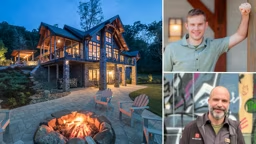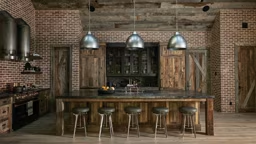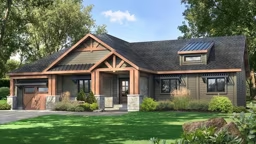
You’ve seen the photographs of the classic Amish barn raising. That’s a timber frame, and it’s used for far more homes than barns these days.
 Timber framing is strong, old and so well-established that they used to just call it building. It forms the basis of a building that has lasted for hundreds of years.
Timber framing is strong, old and so well-established that they used to just call it building. It forms the basis of a building that has lasted for hundreds of years. One of the big advantages of timber-frame construction is that it is so strong it doesn’t need load-bearing walls cutting through the middle of the house, so you can design the layout in any configuration you want, including a totally open great room/dining room/kitchen/entry. The skeleton of timbers can be covered any way you want, so that your timber home can look like any other kind of home and can fit in virtually anywhere.
Timber homes can fit in anywhere
The exteriors of timber homes rarely offer a hint of the interior woodwork. This allows them to fit in with surrounding homes easier than log homes. Yesterday’s timber homes were a far cry from the open-plan, cathedral-ceiling homes that many people associate with timber framing today.Timber homes were the earliest permanent residences built in England’s American colonies and remained the dominant building method until the development of balloon framing, which required little skill to build and answered the growing demand for hastily built mass housing.
See also 8 Steps to a Smooth Timber Home Build
How are log and timber homes different?
 The main distinction between log homes and timber homes is how they use the wood. As a result, they achieve sharply different looks. And because timber homes can use a variety of exterior materials having nothing to do with the inside, they may not be recognizable as timber-frame homes, whereas log homes are always identified as such. In general, log homes have a horizontal profile and timber homes are vertical.
The main distinction between log homes and timber homes is how they use the wood. As a result, they achieve sharply different looks. And because timber homes can use a variety of exterior materials having nothing to do with the inside, they may not be recognizable as timber-frame homes, whereas log homes are always identified as such. In general, log homes have a horizontal profile and timber homes are vertical. These tendencies result from the way the logs are laid and the frame is raised. Ask any timber home owner what’s so special about living in a timber frame and you’re bound to get a different answer each and every time. From the awe-inspiring design options to the close-to-nature feel that seems to ooze from these beautifully handcrafted homes, it’s hard to pinpoint what makes them so special.
To start, the construction method of timber framing has been around for centuries. A symbol of history and strength, timber framing techniques date back to Neolithic times, and since then have been used in many areas of the world, including Japan, Denmark, England, France, Germany, Scotland and the United States. They also have been used to construct buildings and homes during different time periods in history. For example, while ancient civilizations like Egypt and Rome used mostly stone to build, they also used timber framing methods for many of their roof systems.
Today, you can still visit 12th- and 13th-century European churches to see some of the world’s oldest examples of timber framing. In the United States, English settlers in Virginia used the land’s natural abundance of timber to raise a variety of buildings within the walls of Jamestown in the early 1600s.
Timber Frames Today
Since the 1970s, timber framing has become increasingly popular in the world of custom wood homes, and it stands to reason — timber homes offer the best of both worlds. Outside, they usually resemble more conventional homes. Inside, however, they expose artfully crafted timber posts and beams and thought-out joinery, traditionally secured by wooden pegs, to create dramatic interior spaces, often punctuated with lofty trusses.See also 13 Design Ideas for a Cozy Timber Home
 This timber frame provides not only the structure for the home, but also supports the weight of the roof by transferring the load to the frame’s principal posts and the home’s foundation. Other benefits include:
This timber frame provides not only the structure for the home, but also supports the weight of the roof by transferring the load to the frame’s principal posts and the home’s foundation. Other benefits include:
Energy Efficiency
Despite their link to tradition, today’s timber homes have taken the lead in energy efficiency. “When I meet with new clients, I typically describe a timber frame as the visible skeleton of a building. I ask them to visualize a 12-foot-long wall; with conventional construction that wall has ten 2-by-6 studs, each acting as a small post. The insulation is then incorporated between each of the structural members, allowing for thermal bridging at each stud and lowering the cumulative R-value of the wall,” explains Jeremy Bonin, principal architect and owner of Bonin Architects.“In a timber home, on the other hand, large SIPs (structural insulated panels) are applied to the exterior of the frame, almost eliminating thermal bridging and providing a more airtight structure.” Because timber structures are wrapped from the exterior with super insulated walls and roof panels, you not only get to enjoy the beauty of the structure inside the home, but you can achieve some of the best energy efficient-rated walls in the building industry. (Timber homes can realize as much as 35 percent in energy savings with the super insulated enclosures used compared to standard stick-built construction.)
 Design Benefits
Design Benefits
Timber homes boast a number of inherent benefits, but it’s the beauty of the timber beams and the endless amount of awe-inspiring design options and advantages that turn potential homeowners curious about the style into full-blown timber devotees.
Adaptability
When most people envision a timber home, they think of large expanses of wood and sprawling, barn-style ceilings. But to many people’s surprise, timber homes can be built to suit any look or lifestyle. From modern to rustic, cozy to elegant, the options truly are endless.See also Building a Deck at Your Timber Home











